Sun activity for March 31, 2023: A geomagnetic storm is ongoing
The expected disturbance to Earth’s magnetic field arrived earlier today, via sun activity that led to a G1 (minor) storm. The threshold was reached at 5:59 UTC on March 31. A G1 geomagnetic storm means auroral displays are possible at latitudes as low as the northern U.S. states. The storm is due to the arrival of high-speed solar wind from a coronal hole. Unsettled-to-active conditions might persist for the next couple of days, through April 2. So stay alert, aurora watchers!
Last 24 hours: After two days of an active sun, sun activity is back to low. Still, our star never ceases to inspire awe. Active region AR3256 is departing among C class flares. This sunspot was the creator of this week’s X flare, several M flares, and a number of Cs. It produced five C flares out of the 11 over the past day (between 11 UTC yesterday and 11 UTC today). Farewell, AR3256! Shall we see you again? But departing AR3256 didn’t produce the past day’s largest flare. Instead, AR3260, in the sun’s northwest quadrant, produced it: a C4.4 blasted at 9:09 UTC on March 31. The number of sunspot regions on the sun’s Earth-facing side reduced from ten to six today. Newcomer region AR3268 vanished, and the rest rotated out of view.
Sun activity for March 30, 2023: High, with 3 M flares
Sun activity is high with three M flares, including an M5.4 event. Sunspot region AR3256, the producer of yesterday’s X flare, also produced those M flares. This sunspot region continues to provide excitement as it rotates toward the southwest limb (edge). Each M flare caused a radio blackout on the sun-facing side of Earth. AR3263, along with AR3265 and AR3266, is the most magnetically complex region after AR3256. Soon, AR3256 will rotate out of sight. Will any other sunspot regions pick up the flaring mantle? Stay tuned!
Last 24 hours: Sun activity is high with two M1 and one M5.4 flares from AR3256. Three C flares came from AR3256, and the remaining from AR3263. The M flares were:
M1.2 from AR3256 at 14:07 UTC on March 29. R1 (minor) radio blackout over the Pacific Ocean.
M1.1 from AR3256 at 23:47 UTC on March 29. R1 (minor) radio blackout over South America’s east coast.
M5.4 from AR3256 at 07:37 UTC on March 30. R2 (minor) radio blackout over the Indian Ocean.
The sun has ten numbered sunspot regions. Newcomer region AR3268 emerged in the southeast quadrant.
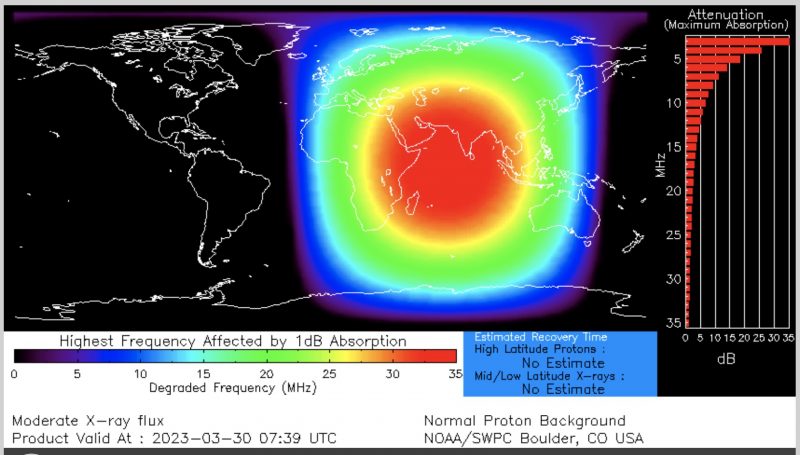
Sun activity for March 29, 2023: BAM! X flare
Sun activity is high, with an unexpected X1.3 flare earlier today (2:33 UTC on March 29). The magnificent explosion happened after days of low flaring from our star: only C flares for several days in a row. The blast came from sunspot region AR3256 on the southwest quadrant, close to the limb (edge). It created an R3 (strong) radio blackout over New Guinea. The flare rose rapidly to X-class threshold – barely reaching an X1.3 – then almost as rapidly fell back to the C-class level. Scientists consider this a noneruptive or impulsive flare, which typically means no associated coronal mass ejection (CME). While we can see an eruption of material from the solar disk, no obvious CME has been observed in other data. But we’re waiting for further analysis to confirm, so stay tuned!
Last 24 hours: Sun activity is high today with an X1.3 flare. The X flare was produced by AR3256 at 2:33 UTC on March 29. Besides this X flare, there were 15 C flares for a total of 16 during the period. AR3256 was the highest flare producer with 10 flares including the X1.3. There are eight labeled active regions on the Earth-facing sun.
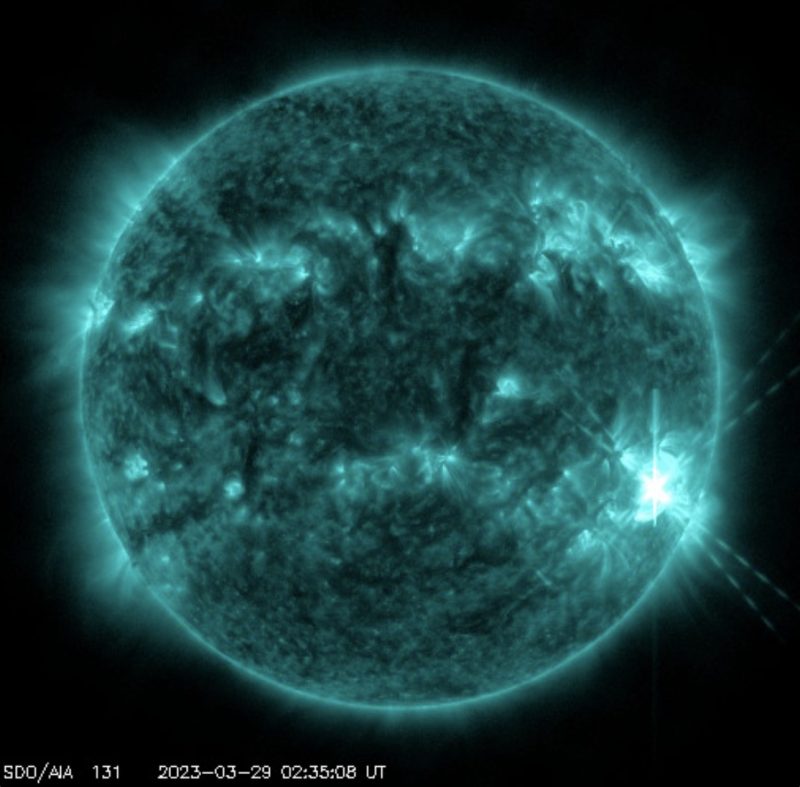
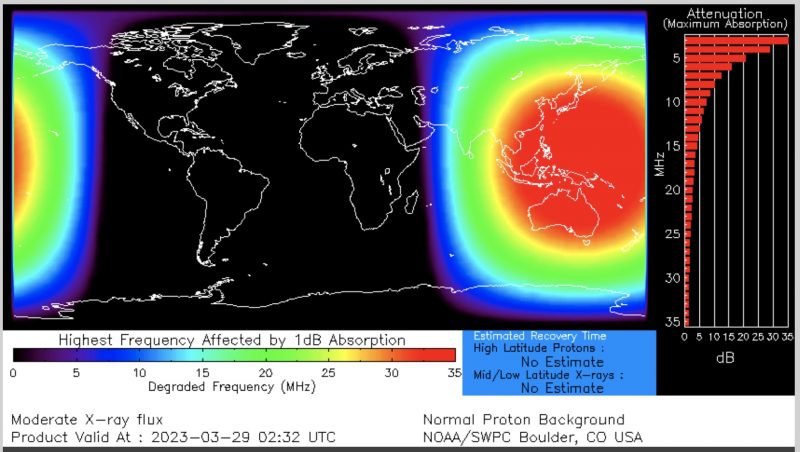
An X1.2 solar flare has been observed from AR3256 in the SW quadrant. The flare was of short duration, and there is no significant CME associated with this event. pic.twitter.com/rPTbVuUFtj
— Edward.Vijayakumar (@edwanx) March 29, 2023
Sun activity for March 28, 2023: Coronal holes and sunspot activity?
Low sun activity continues. While the sun is calm, let’s consider the coronal hole now located near the center of the Earth-viewed solar disk. It’s just north of active region AR3252. Over the past day, we saw this sunspot exploding filaments (see the animation below). And so the question arises … do coronal holes influence sunspot activity? Scientists considered this question in a 2018 paper titled Does Nearby Open Flux Affect the Eruptivity of Solar Active Regions? The authors studied 56 flares during Solar Cycles 23 and 24 (we’re now on Solar Cycle 25). And they say it’s possible that coronal holes do influence sunspot activity, specifically with respect to X flares. This influence might mean that, with a coronal hole so close to this region, things could get interesting. We’ll see. Stay tuned!
Last 24 hours: Sun activity is low. There were seven C flares. The strongest was a C3.6 at 20:46 UTC on March 27, 2023, from an unnumbered region in the southwest. There are nine labeled active regions on the Earth-facing sun today.
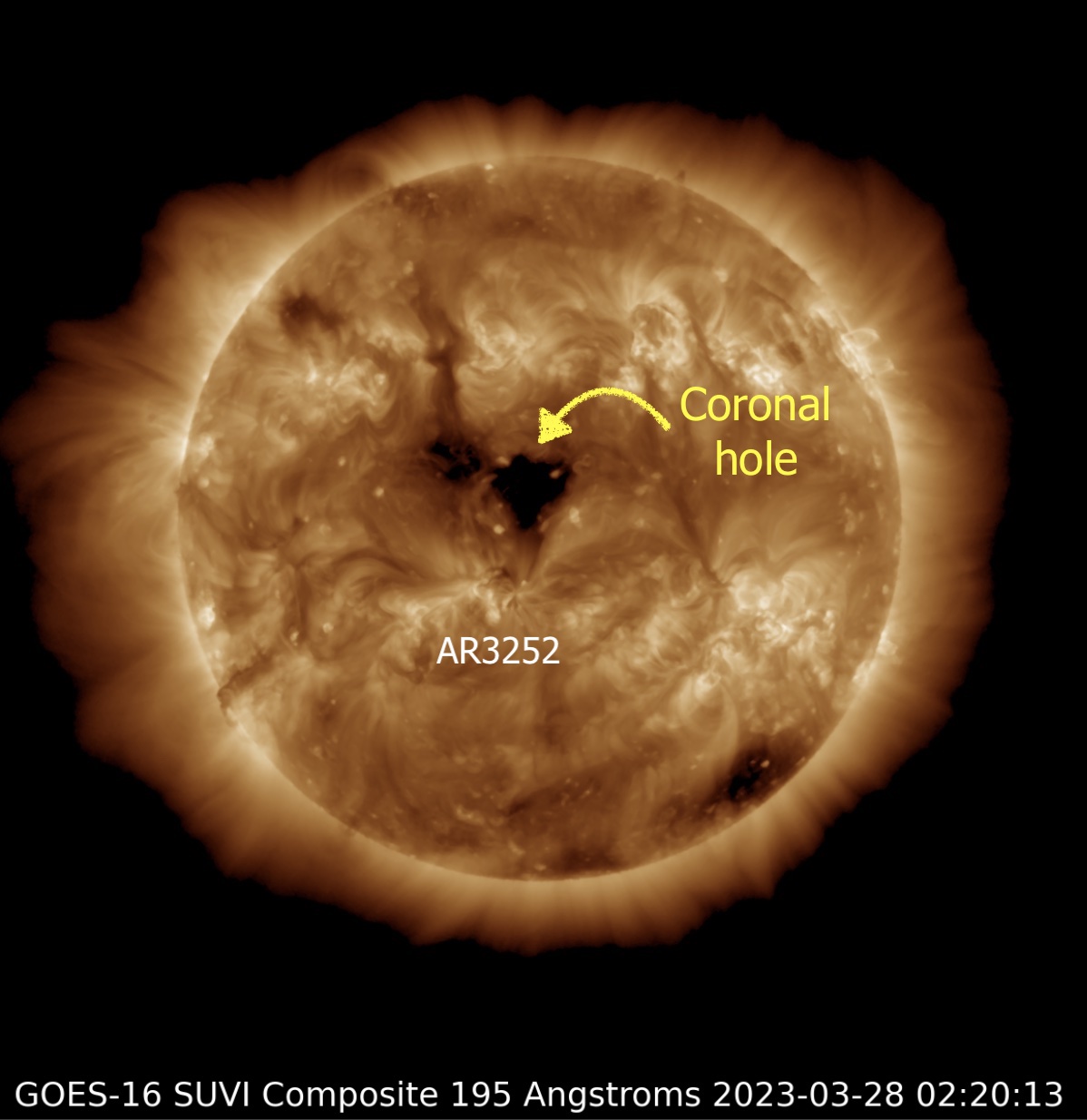
Sun activity for March 27, 2023: Why do sunspot regions form bands?
Sun activity is low. The relative quiet continues not just for flaring, but even in the usual plethora of filament eruptions. Yet the sun has its nine sunspot regions in its northern and southern hemispheres today. And you might notice the regions form two horizontal bands. Why only these two bands? The answer is … we don’t entirely know. The full details aren’t fully understood. We do know that – because of the way magnetic fields inside of the sun are formed – when they become concentrated, they rise to the visible surface giving us sunspots. Over the solar cycle, the sunspots are basically confined to bands between 0 and 30 degrees latitude. As the new cycle begins, the sunspots form near 30 degrees. And then as the cycle progresses they move towards the solar equator (0 degrees). This cycle then starts all over again. If you make a graph of the location of the sunspots over time, they form a pattern that resembles butterfly wings. Hence, the name the solar butterfly diagram. The sun is an exciting star and holds many mysteries that we’re just beginning to understand. Stay tuned for more sun fun!
Last 24 hours: Sun activity is low, with only five C flares. The strongest a C4.6 at 06:32 UTC on March 27, 2023, from AR3256. There are nine labeled active regions on the Earth-facing sun.
Sun activity for March 26, 2023: Even quieter sun
The past day’s sun has been even quieter than the day before. And, at the moment, we don’t see any large regions on the sun’s far side via helioseismology. But the quiet is deceptive, because we’re currently heading toward solar maximum, the peak of the sun’s 11-year cycle, in a few years. And – even while the sun overall is in an upswing of activity – periods of relative quiet aren’t unusual. As we continue on toward the peak of solar activity, around 2025, we’ll see more frequent periods of sun action. And those periods should themselves be more active. But we’ll also see quiet periods like the one we’re experiencing now. And remember … our local star is complex and dynamic. Large sunspot regions can form very quickly, and activity can pick up seemingly out of nowhere. So stay tuned! By the way, thanks to all who submitted aurora photos over this past great week for auroras! Look here for a selection of recent aurora photos, and please share if you have your own photos.
Last 24 hours: Sun activity is low with only one C flare, a C1.1 at 13:01 UTC from AR3258. There are seven labeled active regions on the Earth side of the sun today.
Sun activity for March 25, 2023: After the storm, a calm
Sun activity has been low over the past day (our “day” ends at 11 UTC, and starts at 11 UTC the previous day). But we saw jets and exploding filaments and prominences on the solar disk during the last 24 hours. Take a look at our top animation. Some of those blasts are CME producers, now under analysis to determine any possible Earth-oriented component. Meanwhile, at Earth, we returned to a calm G1 (minor) geomagnetic storm level. Still … wow! The past day featured G4 (severe) geomagnetic storming, 8 on the Kp scale. And there were beautiful auroral displays across the high- to mid-latitudes. We saw reports of auroras witnessed as far south in northern latitudes as Phoenix and Los Angeles in the U.S. Before yesterday, the most recent G4 (severe) storm dates back to September 9, 2017, when G4 and G5 geomagnetic storms occurred. Thanks to all who submitted aurora photos! Look here for a selection of photos from yesterday’s auroral displays. And stay tuned for more sun news.
Last 24 hours: Sun activity has been low during the past day with only C flares, six in total. The largest was a C2.2, which exploded from AR3259 at 13:40 UTC on March 24. There are seven labeled active regions on the Earth side of the sun today. We have a newcomer on the northeast limb (edge) numbered AR3264. And there is an unnumbered region that emerged north of AR3259.
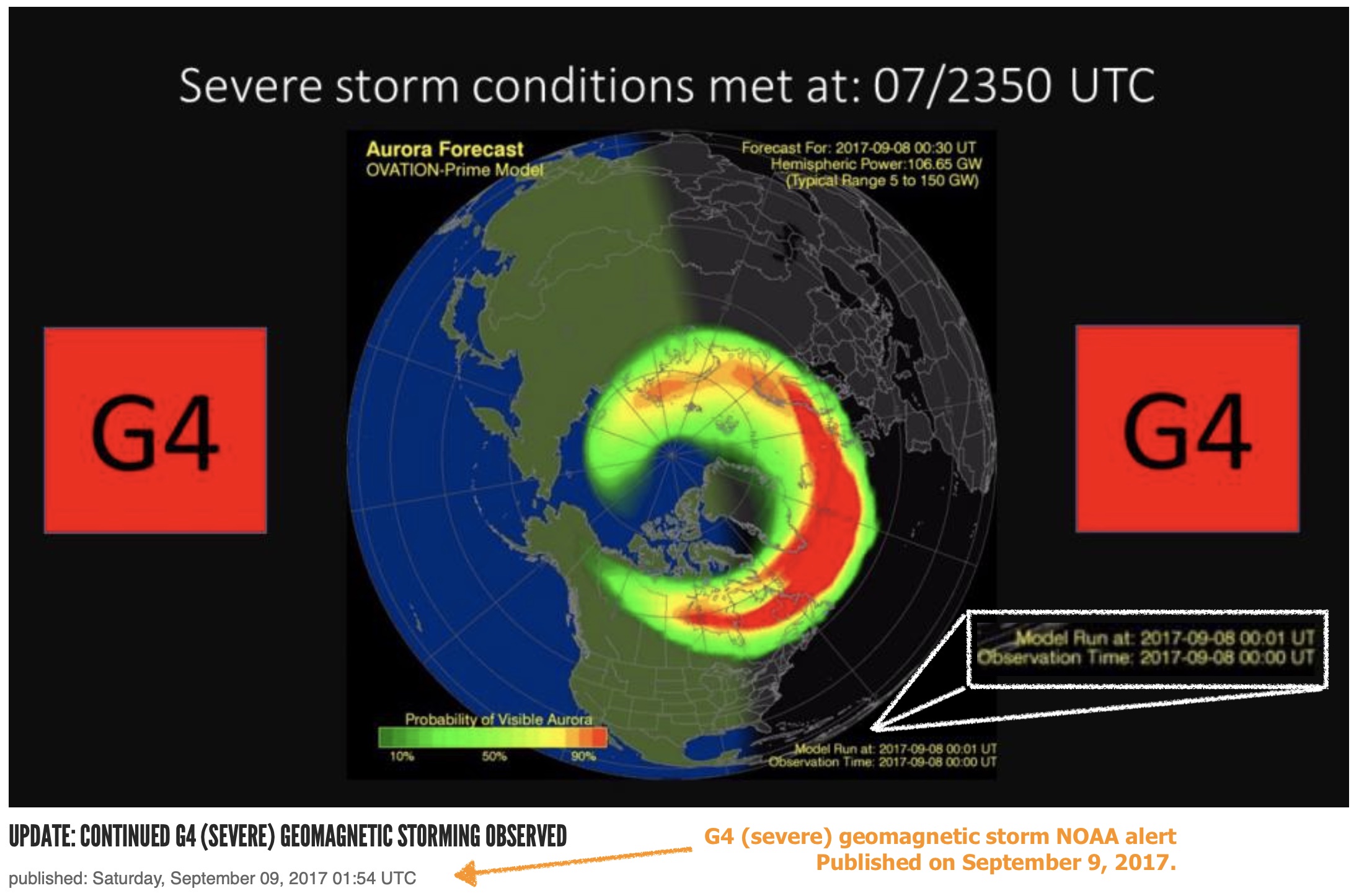

Sun activity for March 24, 2023: BAM! Big night for auroras last night!
Sun activity is low. But wow! What a night for auroras last night! We received a surprising G4 (severe) geomagnetic storm. This unexpected storm started yesterday with a G3 (strong) geomagnetic storm at 14:40 UTC on March 23. After that, Earth’s magnetic field was disturbed for more than 21 continuous hours over the past day. It peaked at G4 (severe) at 4:16 UTC on March 24. Here’s the breakdown of what happened:
First G3 (strong) hit at 14:49 UTC on March 23
G2 (moderate) reached at 19:42 UTC on March 23
G3 (strong) reached at 23:54 UTC on March 23
G3 (strong) at 1:55 UTC on March 24
G3 (strong) at 3:44 UTC on March 24
G4 (severe) reached at 4:16 UTC on March 24
G3 (strong) reached at 9:01 UTC on March 24
This G3-G4 geomagnetic disturbance reached northern latitudes as far south as the U.S. states of Colorado and Wyoming, and to Denmark and the Faroe Islands in Europe. It was all due to the effect of the reported co-rotating interaction region, arrival of coronal mass ejections (CMEs) from March 20-21, and high-speed coronal wind from a coronal hole. All this combined made a highly disturbed solar wind environment that found its way to hit Earth’s magnetic field. It was surprising not only for its strength, but also for its duration: more than 21 continuous hours so far. And it’s still going!
Last 24 hours: Sun activity has been low during the last 24 hours. We saw seven faint flares over the past day, seven B class and two C class flares. The largest was a C1.7 flare at 6:07 UTC on March 24 from region AR3259. The sun has five numbered active regions today.

Sun activity for March 23, 2023: Moderate magnetic storming expected tonight
Sun activity is low today. But on Earth, auroras are ready to rock and roll! NOAA’s forecasters issued an alert for geomagnetic storms G1 (minor) to G2 (moderate) starting at 18 UTC today (March 23, 2023), and extending to 6 UTC on March 24. That means we can expect geomagnetic disturbances in both Europe and the U.S. at northerly latitudes tonight. Northern U.S. states such as Maine and Montana are on the list, and Europe may see auroras as far south as Reykjavik, Oslo, and Stockholm. As we wait for the excitement at Earth, we’re watching that gigantic filament crossing almost the entire northwest quadrant on the sun. And, as there was yesterday, there was another eclipse from space today. But this time it was Earth’s shadow covering the sun from the viewpoint of the NOAA GOES-16 spacecraft (see our image below). Satellites see solar eclipses due to Earth’s shadow more often than it sees eclipses by the moon … because Earth’s shadow is so much bigger than the moon. In fact, a low Earth-orbiting spacecraft, like NASA’s Solar Dynamics Observatory (SDO) has an Earth-eclipse season lasting a few weeks twice a year.
Last 24 hours: Sun activity is low. We saw 12 C flares over the past day. The largest was a C2.6 flare at 19:57 UTC on March 22 from region AR3259. AR3259 is the lead flare producer. The sun has six numbered active regions. We have a newcomer on the southeast limb (edge) numbered AR3262.
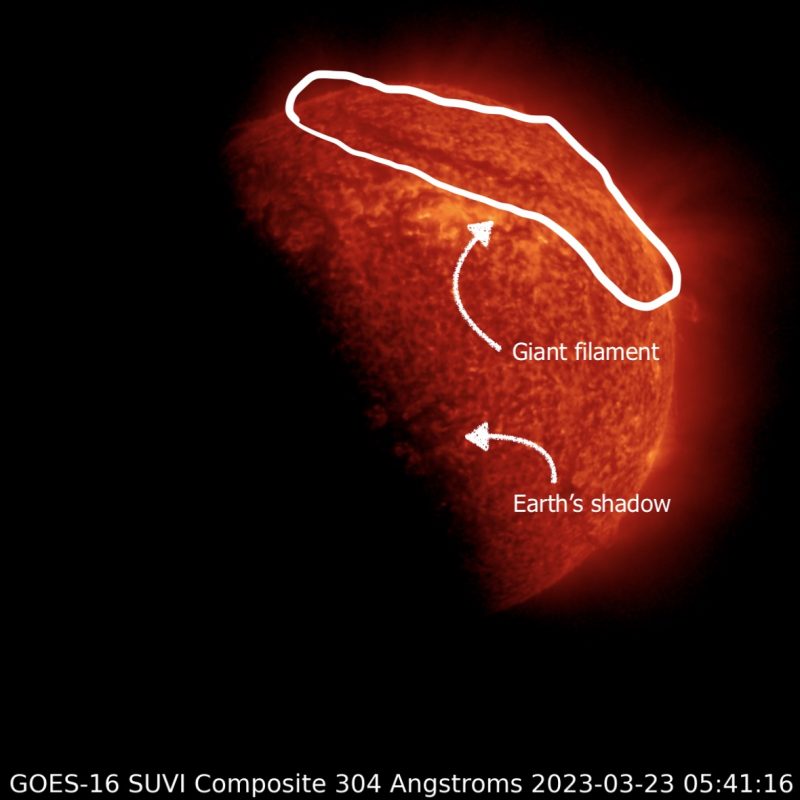
Sun activity for March 22, 2023: A solar eclipse from space
We at EarthSky were watching a giant filament in the sun’s northern hemisphere this morning with NOAA’s GOES-16 SUVI instrument. Oops! What was that? It’s the moon! GOES saw a partial solar eclipse from space. It happened at around 1:29 UTC on March 22. GOES-16 is a powerful weather satellite. It usually looks at western North America (including Alaska and Hawaii). But it has solar observing capabilities, too. That – plus its distance from Earth of 22,000 miles (34,000 km) – let us capture this morning’s special moment. In fact, the sun, Earth, and moon are nearing the special geometry that will allow us on Earth to see an eclipse, too. On April 20, 2023, those in Timor-Leste and Indonesia (West Papua and Papua) and the tip of Australia will experience a hybrid solar eclipse. Parts of the eclipse path on Earth will see an annular eclipse. And parts of the eclipse path on Earth will see a total eclipse.
Last 24 hours: Turning heads back to our sun, sun activity is low today. Eight C flares were observed. The largest was a C4.6 at 13:53 UTC on March 21, from AR3257. The sun has five numbered active regions.
Sun activity for March 21, 2023: Equinoxes and aurora season
Sun activity is low. But the March equinox arrived at 21:24 UTC (4:24 p.m. CDT) yesterday. So it’s aurora season! For over a century, scientists have noted an increase in auroras around the time of the March and September equinoxes. Modern scientists most often describe it as the Russell-McPherron effect, a physical connection between the geometry of Earth’s magnetic field and the magnetic field carried to Earth from the sun by the solar wind. And indeed we’ve had some nice geomagnetic activity over the past week (see image above). And we had auroras last night from Europe to Alaska (see tweets below). Read more about aurora season, and stay tuned for aurora alerts!
Last 24 hours: Sun activity is low, with only nine C flares. The largest flare was a C4.4 at 15:34 UTC on March 20, from an unnumbered active region on the northeast close to AR3258. There are six numbered active regions on the sun.

Sun activity for March 20, 2023: Large coronal hole
Happy equinox! Two coronal holes are in the southern hemisphere. The high-speed solar wind has already started to buffet Earth from the smaller one. The larger one will be in a geoeffective position in a few days. This means that it will soon be in the prime position for its high-speed solar wind to sweep past Earth. High-speed streams of solar wind can rattle the geomagnetic field when it blows past Earth. This can induce geomagnetic storms with enhanced aurora and the larger coronal hole could have a larger impact in a few days. We are also waiting for a glancing blow from a coronal mass ejection (CME) caused by a March 17, 2023, filament eruption. This could boost any geomagnetic activity from the coronal holes giving a better chance for geomagnetic storming and more aurora.
Last 24 hours: Sun activity is moderate. The largest flare was an M1.3 at 2:10 UTC on March 20 from AR3256. There were eight C flares in the past 24 hours. We are waiting for newer regions on the eastern limb (edge) to rotate into view. They may bring increased activity including possible CMEs that could enhance the blowing solar wind. There are five numbered active regions on the sun today.
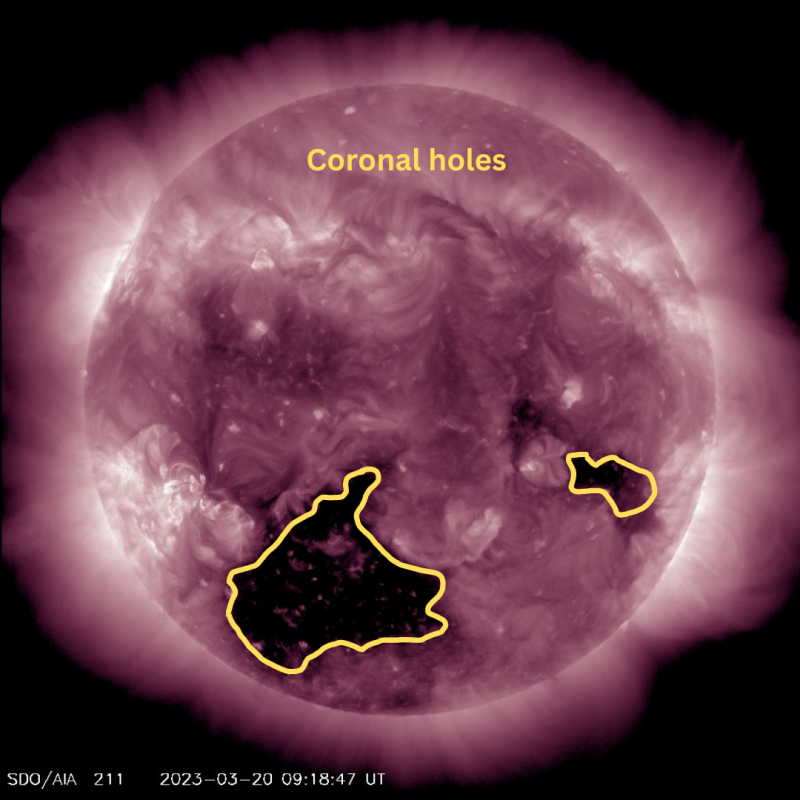
For more details, visit our Sun Glossary
Sun activity for March 19, 2023: Filament fun
Sun activity is low. But the sun doesn’t know that! Over the past several days, it has been throwing off a flurry of filaments. Two erupted from the southwest limb (edge) over the last half of March 18, 2023. Both events created coronal mass ejections (CMEs), but given their location neither will have a brush with Earth. We mostly think of solar activity in terms of erupting sunspot regions. But, for some excitement, we shouldn’t count out filament eruptions. They’re not usually the fastest of the CME events. But when an erupting filament is over an active region, the action is often kicked up a notch. We will see more of these crazy combos of filaments over active regions as we approach solar maximum, when the sun builds up more magnetic energy that it needs to shed. Stay tuned!
Last 24 hours: Sun activity is low. There were 12 C flares. The largest was a C4.5 at 6:41 UTC from AR3256. There are six numbered active regions on the sun.
Sun activity for March 18, 2023: Huge blast on solar southwest
Sun activity has been moderate, but we saw a huge blast from the sun’s far side. It happened late on March 17, 2023, starting at around 22 UTC and lasting several hours. The explosion was close to the sun’s southwest limb (edge). It produced a large, gorgeous prominence. The coronal mass ejection (CME) sent into space during this event is not Earth-directed; it happened on the sun’s far side, after all. Meanwhile, most of the active regions we’ve been seeing in recent days have either decayed or been carried out of view on the sun’s western edge. And now we see only three active regions. Despite all this, NOAA‘s forecasters increased to 95% the chances for a C flare to occur. That might be because of AR3256, possibly the next guy to observe. See below.
Last 24 hours: Sun activity is moderate. Surprised? We saw eight flares in the past day, seven Cs, plus an isolated M1.1 flare that was the day’s largest. AR3254 produced the M flare at 15:07 UTC on March 17, 2023. Shortly afterwards, there was an R1 (minor) radio blackout over South America. There are only three numbered active regions on the sun today. But there’s a newcomer on the southeast limb (edge), now numbered AR3256. This active region shows a good-sized extension and a beta magnetic configuration. That means it has a positive and a negative polarity, with a simple division between the polarities.
Sun activity for March 17, 2023: Parker Solar Probe and Mercury
Two milestones today, the first involving physical distance and the second a matter of perspective. First, Parker Solar Probe – the first spacecraft to “touch” the sun – has its 15th perihelion, or closest approach to the sun, today. And second, the sun’s innermost planet Mercury is at superior conjunction today, passing most directly behind the sun as seen from our earthly perspective. Parker Solar Probe launched on August 12, 2018. At this March 17, 2023, perihelion, it’s sweeping within 7 million miles (11 million km) of the sun’s surface. That’s much closer the previous current record-holder, Helios 2, which came within 27 million miles (43 million km) of the sun in 1976. And of course it’s in contrast to Earth’s distance from the sun (93 million miles, or 150 million km). Parker Solar Probe is traveling at a speed of 347,675 mph (559,530 kmh). It’s zooming past our blazing star! To complete the show today, Mercury is at its superior conjunction. That means that – from our earthly perspective – Mercury lies right next to the sun in our sky. It’s passing behind the sun (more or less) as seen from Earth. Today, we see Mercury in the field of view of the LASCO C2 imagery of NASA’s SOHO spacecraft.
Last 24 hours: Sun activity is low, with eight C flares. The largest flare of the past day was a C6.4 flare from an unnumbered region in the sun’s southeast quadrant at 6:26 UTC on March 17, 2023. Just minutes after that flare, a second C6.4 flare exploded so nearby in the sun’s southeast that it might be considered a blast from the same region. The sun continues emitting jets and prominences on its southeast limb (edge). A long-lasting prominence on the sun’s northern pole is ongoing. There are seven numbered active regions on the sun today.
Sun activity for March 16, 2023: Auroras galore
Earth’s magnetic field reached G2 (moderate) storm levels late yesterday and early today. Observers at northerly latitudes witnessed auroras across higher latitudes. Meanwhile, the sun itself remained relatively quiet. The effects of the massive coronal mass ejection (CME) from the sun’s far side – which created a history-making halo event a few days ago – have now started to wane. The S1 (minor) solar radiation storm created in the halo event – which we saw during the past couple of days – is also subsiding.
Last 24 hours: Sun activity is low, with just two little C flares. We say “little,” but, according to this page from University College London, the amount of energy that’s released in a typical flare is about the same as 100 megaton bombs exploding all at once! The largest flare of the past day was a C1.3 flare from an unnumbered region on the northwest at 06:43 UTC on March 16, 2023. Jets on the sun’s southeast limb (edge) continued along with a long-lasting prominence on the northern solar pole. Will the region that produced the historic eruption on the other side return soon to the Earth-facing side of the sun? It might. We’ll see. There are eight numbered active regions on the sun today.
Sun activity for March 15, 2023: Aurora alert now and tonight
At the time of this writing (11 UTC on March 15), a G2 (moderate) geomagnetic storm is ongoing. Auroral displays are possibly occurring as far south as the northern U.S. states … And more is coming. The G2 threshold (Kp = 6) was reached at 05:59 UTC on March 15, 2023 (last night in the U.S.). Tonight’s forecast anticipates continued geomagnetic storming up to a G2 (moderate). Alert for aurora chasers! Please submit your aurora photos to EarthSky’s community page. Meanwhile, we’re still seeing the effects of the massive coronal mass ejection (CME) from the sun’s far side, which created a history-making halo event. An S1 (minor) solar radiation storm of solar energetic particles is ongoing as we write this. We will keep watching. Stay tuned.
Last 24 hours: Sun activity is low with four C flares. The largest was a C2.9 flare by AR3254 at 11:19 UTC on March 14, 2023. There was a large beautiful jet on the sun’s southeast limb (edge): A sign of more action to come? There are nine numbered active regions on the sun’s Earth-facing side today.
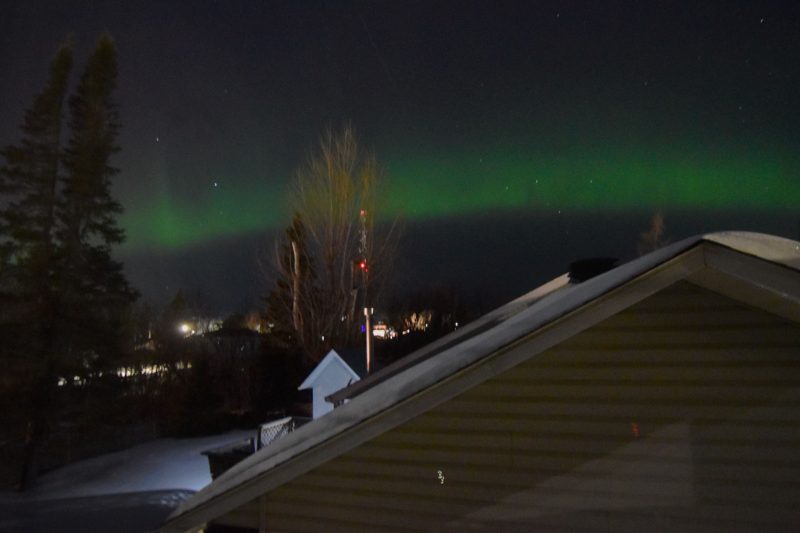
Sun activity for March 14, 2023: This week’s history-making halo event
We’re still seeing the effects of the massive coronal mass ejection (CME) from the sun’s far side, the side we can’t see from Earth. It happened around 3:30 UTC on March 13, 2023 (overnight on March 12, for the Americas). If this backside eruption had happened on the sun’s Earth-facing side, we could have experienced a solar event as big as – and maybe bigger than – the most infamous solar event in modern history, the Carrington Event of September 1859. A simple explanation of space weather is that CME size and speed play an important role is determining the significance of the impact of an event. There are also other variables, for which we are waiting for data. All of this together will determine if something “could happen.” That gigantic CME was noteworthy in 1859. But, given our modern dependence on technology today, its effect – if it happened today – would have been profound. We’re lucky this week’s event happened on the far side! And – as a more advanced society than that of 1859 – we have a spacecraft, Parker Solar Probe, on the side of the sun where the event occurred. It’ll provide unprecedented data on this history-making sun event. Solar scientists are likely giddy with anticipation, waiting for the data to become available. And, in the meantime, Earth is still experiencing an increase in solar energetic particles, which are creating radio blackouts at Earth’s magnetic poles. It’s very likely the March 12-13 event will end up being the largest coronal mass ejection of Solar Cycle 25. Only one such event is statistically expected per solar cycle.
Last 24 hours: On the Earth-facing side of the sun, activity is low: Only four C flares. The largest flare, a C3.1, was produced at 11:06 UTC on March 13, 2023. It originated from an unnumbered active region on the northeast. There are seven numbered active regions on the Earth-facing side of the sun.
Sun activity for March 13, 2023: Today’s strong halo event
The Earth-facing side of the sun is quiet. Flaring is low. But check this out … A strong halo event on the far side of the sun! That is, a huge coronal mass ejection (CME) was seen earlier today (around 3:30 UTC on March 13, 2023) in the SOHO/LASCO C2 imagery. It appeared to come from all around the edge of the field of view. Solar physicists call it a halo event because, in the imagery, it looks like a ring or halo. Yet there’s no signature of an eruption on the Earth-facing side of the sun. So we know the event must have come from the sun’s far side, and it looks like a doozy. In fact, today we’re hearing the word Carrington mentioned in connection with the strong halo event. Good thing the CME wasn’t pointed our way. This farside eruption did cause an increase in “TV snow” on the LASCO camera. And it caused a marked increase in protons measured on Earth. This means the event on the other side of the sun created a blast strong enough to quickly accelerate the protons. The event releasing the protons is called a solar particle event (SPE). If the level of protons continues to increase, they could reach NOAA’s threshold for a particle storm. We are awaiting more analysis to see if and how much the proton levels rise. Not too boring for low activity! For more info, see the tweet below.
Last 24 hours: Sun activity is low. In addition to the halo event described above, a filament erupted from the southeast solar disk, sending a coronal mass ejection (CME) into space around 18:15 UTC on March 12, 2023. We’re waiting for further analysis to see if the CME has an Earth-directed component. We also saw three C flares during the past day. The largest flare, C1.6 at 10:40 UTC on March 12, 2023, came from the new region AR3245. There are 10 numbered active regions on the Earth-facing side of the sun.
Sun activity for March 12, 2023: Large filament eruption with CME
Sun activity is low. But even when solar flaring is low, the sun still has some tricks up its sleeve. For example, another large rope of solar material and magnetic field – aka a filament – erupted from the sun’s southwest around 16 UTC late yesterday (March 11, 2023). Filament eruptions can put on quite a show! And the 304-angstroms wavelength of NASA’s Solar Dynamics Observatory (SDO) captured it. Then the LASCO C2 coronagraph of the Solar and Heliospheric Observatory (SOHO) picked it up, in the form of its resulting coronal mass ejection (CME). The CME is now under analysis to determine if it has an Earth-directed component. Meanwhile, we await the possible arrival of a March 8 CME sometime today. It could power enhanced auroral displays at higher latitudes. Good luck, aurora-watchers!
Last 24 hours: Sun activity is low with six C flares during the past day. Five came from region AR3245. The largest event, C3.2 at 7:43 UTC on March 12, 2023, came from the new region AR3253. There are 10 numbered active regions on the Earth-facing side of the sun.
Sun activity for March 11, 2023: CMEs in the sun’s southwest
Sun activity is low. But the long-lasting prominence on the sun’s southeast limb (edge) – which we’ve reported on for the past two days – is still going! And check out these coronal mass ejections (CMEs), produced on the sun’s southwest quadrant during the past day, by unlabeled active regions.
CME at 00:38 UTC on March 11 from a filament explosion.
CME at 17 UTC on March 10 from a region of filaments and plages.
CME at 13:33 UTC on March 10 from a C2.5 flare from a plage region (site of the now-decayed AR3240).
Last 24 hours: There were eleven C flares during the past day, considered low sun activity. Five were blasted by AR3245, including the largest, a C4.9 which exploded at 1:03 UTC on March 11, 2023. There are 10 numbered active regions on the Earth-facing side of the sun today.
Sun activity for March 10, 2023: A long-lasting prominence gets stronger
We’ve been watching a prominence on the sun’s southeast limb (edge) since yesterday (March 9), and now it’s getting larger and stronger. Meanwhile, there was a filament explosion in the sun’s northeast, not far from the limb, starting late yesterday, around 23:30 UTC. It came from a region now numbered AR3252 and produced a CME and a prominence. Read about filaments and prominences here. By the way, time flies! Today is the first anniversary of the EarthSky Sun Team, which consists not just of the authors of this post, but also editors, proofers, fact-checkers and archivers – all of whom work together joyfully, early each morning, to bring you these daily posts on our local star. And, of course, thank you, who read and support us. Happy anniversary to us!
Last 24 hours: Sun activity is low, with only C flares – 13 in all – during the past day. The largest was a C7.1 blasted by AR3245 at 7:08 UTC on March 10, 2023. This active region, AR3245, was the leading producer of the day with six flares. There are three newcomers on the Earth-viewed side of our sun today, now labeled AR3250, AR3251 and AR3252. The sun bears 11 labeled active regions.
Sun activity for March 9, 2023: An elegant visitor
The sun’s innermost planet, Mercury, has now started to show on LASCO C3 imagery. In the first few days of March, we saw this planet in our eastern sky before sunup. But now Mercury’s short orbit around our local star – just 88 days – has carried it to the far side of the sun, as seen from Earth. Now, thanks to our spacecraft technologies, we can look forward to seeing Mercury’s passage near the sun (superior conjunction) from our earthly vantage point. Mercury will be most behind the sun as viewed from Earth on March 17, 2023. Then it will pass not directly behind the sun, but about 1.5 degrees from the sun on our sky’s dome. What then? Mercury will speed on in its orbit! And it’ll return to our evening sky, perhaps to be visible near Jupiter in the last few days of March. Follow Mercury in the LASCO C3 imagery here. See the Mercury-Jupiter chart below. And visit EarthSky’s night sky guide!
Last 24 hours: Sun activity is moderate, with the emission of one M1.3 flare and 16 C flares, for a total of 17 flares during the past day. Sunspot region AR3248 produced the M flare at 22:33 UTC on March 8, 2023. The blast provoked a R1 (minor) radio blackout over an area in South Pacific Ocean. The sun today has nine numbered active regions.
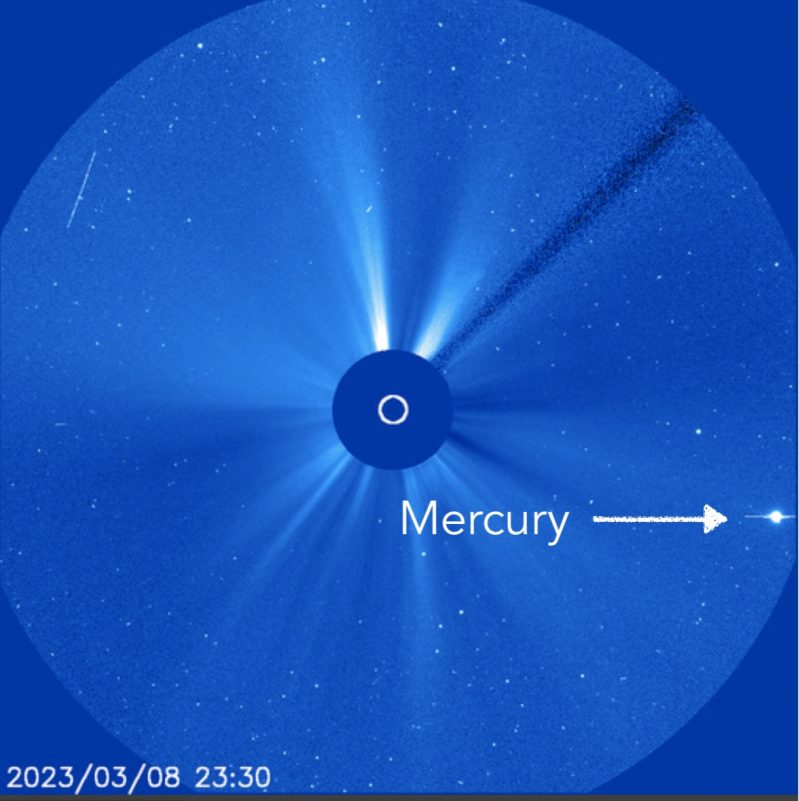

Sun activity for March 8, 2023: Today’s 2 biggest sunspot regions
Sunspot AR3242 is the largest on the sun now. The other large sunspot is AR3245, which has been growing in size since its appearance on March 3, 2023, and now shows a split umbra (the umbra is the inner, dark, cool part of a sunspot). Will one of these two guys provide an X flare shortly? For now, AR3242 produced the M flare of the day. Read more details below.
Last 24 hours: Sun activity is moderate. There was an M1.2 flare event – from AR3242 – just before closing this edition at 10:32 UTC on March 8, 2023. The blast provoked a R1 (minor) radio blackout over an area in South Africa. Besides this M flare, there were eight C flares, for a total production of nine flares during this period. There’s a newcomer on the Earth-viewed side of our sun. On the southeast limb (edge), the sun’s rotation carried an active region into view, now labeled AR3249. In the meantime, AR3243 has gone behind the northwest limb. And none of the rest of the active regions decayed. So the sun today – as yesterday – has 11 labeled active regions.
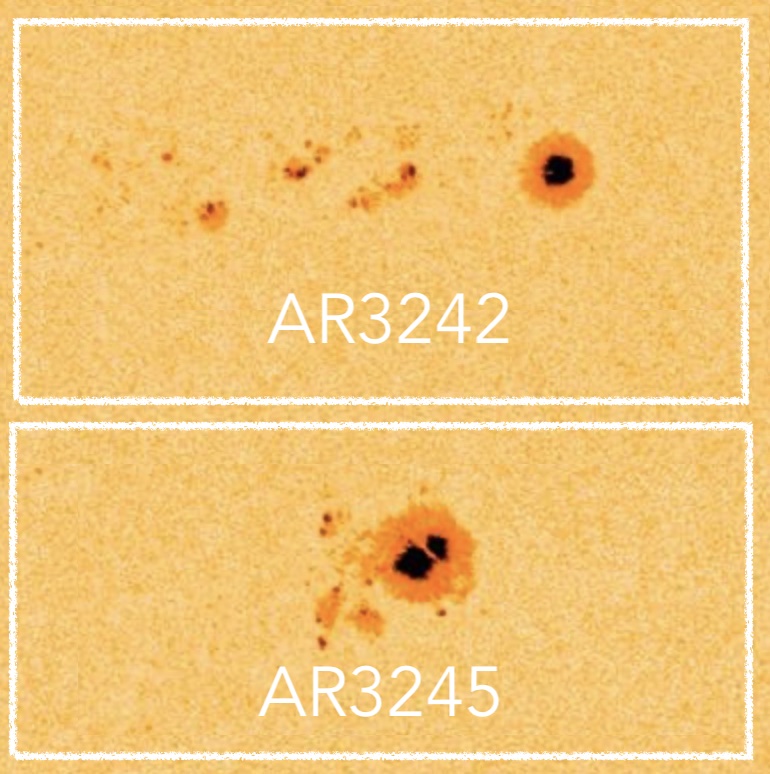
Sun activity for March 7, 2023: Low activity, many sunspots
After an intense period with high M flaring, sun activity is low. We saw fewer flares, mostly only C flares and one M flare, over the past day. Yet, today’s sun bears a large number of sunspots, one of the largest so far this year, on its Earth-viewed side: 11 labeled active regions. The largest in size is active region AR3242 which already produced today’s M flare (see details below). Meanwhile, AR3243 – which gave us most of yesterday’s activity – is at the very edge of the sun today, on the northwest limb, departing among exploding filaments and prominences.
Last 24 hours: Sun activity is low with 10 Cs and one M flare, for a total of 11 flares. The largest was the M1.0 flare from active region AR3242, which happened at 17:50 UTC on March 6, 2023, and produced a R1 (minor) radio blackout that affected an area over the west coast of South America. There are also a couple of newcomers on the solar disk. AR3247 came into sight on the sun’s southeast limb (edge), carried into view by the sun’s rotation. And AR3248 emerged on the northwest quadrant, close to AR3238.
Sun activity for March 6, 2023: Deja vu all over again
Today’s top news: Sunspot region AR3234 has passed the baton to AR3243 (figuratively speaking). The last 24 hours almost look like both deja vu and seeing double, with two new M5 solar flares from the new champion AR3243. Just as we saw yesterday, AR3242 is not far behind with two M1 flares. And – although it’s now gone – AR3234 had its own M1 flare at the end of the period. This is some exciting sun activity! All of the M flares were impulsive; the impulsivity of a solar flare shows how quickly the initial energy release happens. This general distinction between what scientists call impulsive versus gradual or extended emission points to whether or not the flare had enough energy to propel a coronal mass ejection (CME). As of now, none of these impulsive flares appear to have produced CMEs, though. The big question is … will one of these regions – AR3242 or AR3243 – also give us an X flare, as AR3224 did? Stay tuned for what’s next!
Last 24 hours: Sun activity is high, due to five M flares including an M5.8 and M5 from sunspot region AR3243. The two M5 flares occurred within five hours of one another. The complete list of M flares in order is:
M1.1 at 16:58 UTC on March 5, 2023 from AR3242,
M1.0 at 17:11 UTC on March 5, 2023 from AR3242,
M5.0 at 21:41 UTC on March 5, 2023 from AR3243,
M5.8 at UTC 02:35 on March 6, 2023 from AR3243, and
M1.3 at UTC 09:28 on March 6, 2023 from AR3234. All of the M flares produced radio blackouts on the sunlit side of Earth.
Sun activity for March 5, 2023: It’s an M palooza!
There’s been a spectacular showing of M flares over the past day. We had an eruptive M5.3 flare from the departing sunspot region on the sun’s western limb (edge) late in the day yesterday. And we had multiple M1 flares including from one of the newer regions on the sun’s eastern limb (edge). Another newer region tried to keep up, coming close to M with a C8 flare. Because we have flaring over the M5 level plus several additional M flares, sun activity is considered high. The M5.3 flare also produced a spectacular coronal mass ejection (CME) off the sun’s western limb (edge). See the tweet below. But it was not Earth-directed. Our prolific flaring region, AR3234, is largely gone from sight now, but we have two new regions to watch, AR3242 and AR3243. Will one of these regions also give us an X flare as AR3224 did? Stay tuned for what’s next!
Last 24 hours: Sun activity is high, due to an M5.3 flare from AR3224. The region produced an M1 flare and the new region AR3242 gave us an M1. The other new region AR3243 tried to squeak out an M but fell short with a C8 flare. The M5.3 flare occurred at 16:13 UTC on March 4. All of the M flares produced radio blackouts on the sunlit side of Earth.
Sun activity for March 4, 2023: Bam! X flare late yesterday
Sunspot region AR3234 has been a powerhouse during its pass on the Earth-viewed side of our star. And, late yesterday, just as it was about to be carried out of view by the sun’s rotation, it blasted out an X2.1 flare. The explosion happened at 17:52 UTC on March 3, 2023, at the edge of the sun’s northwest limb. It was the cherry atop the cake for this powerhouse active region, which also gave us 10 M flares in recent days. The X flare blast provoked an R3 (strong) radio blackout that affected an area on the west coast of South America. As anticipated, AR3234 left the visible side of the sun among beautiful prominences. See the animated image below.
Last 24 hours: Sun activity is high due to the X2.1 flare, the largest of the past day, blasted out by AR3234. Overall, we’ve seen an increase in flare production in the past day consisting of 21 flares: 19 C, one M and one X class flare. AR3242 was the biggest producer of the day, with 14 flares. The M1.0 flare from AR3243 at 07:10 UTC on March 4, 2023. provoked an R1 (minor) radio blackout over an area in the southern Indian Ocean. There’s a newcomer on the southeast limb (edge), now numbered AR3245. Today the sun bears nine labeled active regions.
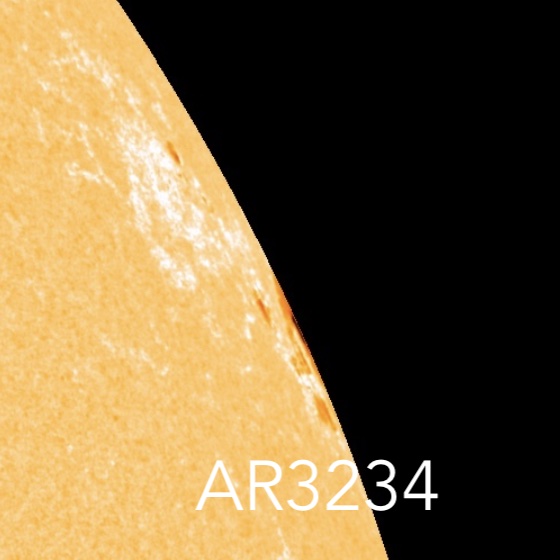
Sun activity for March 3, 2023: Another M flare from AR3234
Sun activity is moderate today, with an M3.8 flare from AR3234. As mentioned yesterday, this region has been a powerhouse. It produced the M3.8 flare (its farewell flare?) at 21:16 UTC on March 2, 2023. The blast provoked an R1 (minor) radio blackout that affected an area over French Polynesia in the South Pacific Ocean. AR3234 is still in its beta-gamma-delta magnetic configuration, a powerful configuration for flaring. Will it give us an X flare before departing?
Last 24 hours: The sun produced nine flares in the past day, one M and eight C, making it a moderate activity day. The largest was the above-mentioned M3.8 flare from AR3234. This region also produced five flares out of the nine of the past day. Meanwhile, on the sun’s southeast limb (edge), another active region is coming into view. It’s not labeled yet as of this writing (11 UTC on March 3). In fact, it barely can be seen. But it has already produced a beautiful prominence (see the animated image below). The sun has seven labeled sunspot regions today.
Sun activity for March 2, 2023: A powerhouse departing
Sun activity is low. The main producer of flares in recent days – sunspot region AR3234 – is about to be rotated off the Earth-facing side of the sun. This region produced the M8.6 flare – almost an X flare – that erupted late on February 28. Experts now believe the associated coronal mass ejection (CME) to that flare might give Earth a glancing blow on March 4, hopefully producing more auroral displays. So … we’ll miss you, AR3234! During its recent trip across the sun’s visible face, this region produced nine M flares plus numerous C flares. And – while leaving – it still shows a beta-gamma-delta magnetic configuration, the most magnetically complex active region on our star. And that’s why we’re still watching!
Last 24 hours: Sun activity is low, with 17 C flares. The largest was a C9.2 from AR3234 at 04:50 UTC on March 2, 2023. The region produced seven C flares, the most during the past day. Meanwhile, two new active regions have rotated into view on the sun’s east limb (edge), AR3240 and AR3241. The sun has six labeled sunspot regions today.
Sun activity for March 1, 2023: Almost an X-flare!
Sun activity is high. An M8.6 flare – almost an X flare – erupted from sunspot region AR3234 late yesterday. This is the same region whose two CMEs drove the magnetic roller coaster ride of Earth’s magnetic field in recent days, giving us amazing auroral displays. The wild geomagnetic ride ended early yesterday (February 28). But, before it was over, people were seeing auroras as far south as the U.S. state of Colorado. And the BBC reported on a pilot who circled his plane to show passengers the northern lights. What a show! And we can expect more, as we head toward solar maximum in mid-decade.
Last 24 hours: Sun activity is high with the M8.6 flare from AR3234. It happened at 17:50 UTC on February 28, 2023. The region also gave us an M1.0 flare and produced 13 of the 16 C flares during the past day. Both M flares produced radio blackouts over the sunlit side of Earth. The M8.6 flare produced an R2 (moderate) blackout over the west coast of South America and the M1 produced an R1 (minor) blackout over the east coast of Australia. The sun has six labeled sunspot regions.
Bottom line: Sun activity archive for March 2023. A daily record of flaring, and other sorts of activity, on our local star.











